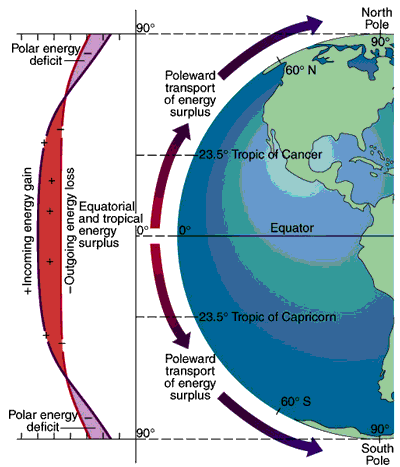THE NATURAL ENVIRONMENT
Geography 101
ToC
HEAT
Albedo
Greenhouse
Balance
Global
Local
Energy Balance
Energy and mass balances, also called budgets, are common methods in environmental studies. Quite simply, whatever mass or energy enters a system is set equal to the mass or energy leaving the system plus the change within the system (energy in = energy out + change). This simple device helps to illustrate some very fundamental features of our planet's climate.

Planetary Energy Balance
Over a complete year, planet Earth absorbs the same amount of energy from the sun as it emits to space as terrestrial (emitted by Earth) radiation, regardless of the magnitude of the greenhouse effect. This has to be true, or Earth would be heating or cooling over time instead of maintaining the stable average temperature we see today. While the planet as a whole has a balanced energy budget, the balance at individual locations varies greatly, as shown in the diagram.
The diagram illustrates what a satellite in space would detect if it measured terrestrial radiation leaving the Earth and compared it with solar radiation absorbed by the Earth for a whole year for each latitude. The satellite would record that tropical areas receive more radiant energy from the sun than they lose to space through terrestrial radiation, and vice versa for polar areas. In other words, incoming energy exceeds outgoing energy for the tropics and outgoing energy exceeds incoming energy for the polar areas.
Perhaps this seems obvious: the tropics are warmer than polar areas. But our aim here is to understand the fundamental reasons for this temperature difference and its relationship to wind and ocean currents.
The energy deficit and surplus by latitude can be further illustrated with representative numbers for the energy balance (all values given in watts per square meter) shown in the table.
Sample Planetary Energy Balance Values |
|||||
energy in |
= |
energy out |
+ |
change |
|
Tropical Area |
200 |
= |
180 |
+ |
20 (surplus) |
Polar Area |
100 |
= |
120 |
- |
20 (deficit) |
Earth has an energy surplus in the tropics and an energy deficit for the polar areas. In a fundamental way, this difference drives the global winds and ocean currents. Their motion sends tropical heat to high latitudes. Think of Earth as a huge solar hot water heater. Ocean water and air are heated by the sun in the tropics (like solar panels heating water on a rooftop), then whisked off to high latitudes where they drop off heat (like heating the bath water), and then returned to the tropics to be re-heated by the sun (like the cooled water recirculated to the roof).
All of our major weather systems and ocean currents are a direct result of this constant flow of heat from the tropics to the poles. Without that circulation, the tropics would be hotter and the polar areas colder than they are today.
|
|
BOX 1 |
Surface Energy Balance
On a smaller scale, the energy balance also determines local air temperature differences. Simply put, sunlight heats the Earth's surface and this energy is converted to three basic forms: longwave radiation, latent heat by evaporation, and sensible heat. Putting these components into the generic formula: energy in = energy out + change, and considering a full day to minimize the change value, gives:
Sunlight = Longwave + Evaporation + Heating Air
 To
see how the energy balance affects air temperature, consider a dry
lava flow near a wet forest in Puna on the Big Island. Intuitively, you know that the air is hotter over the lava flow than the forest, but the energy balance exlains why. Typical energy values for a sunny
day (ignoring change) are given below.
To
see how the energy balance affects air temperature, consider a dry
lava flow near a wet forest in Puna on the Big Island. Intuitively, you know that the air is hotter over the lava flow than the forest, but the energy balance exlains why. Typical energy values for a sunny
day (ignoring change) are given below.
Sample Surface Energy Balance Values (W/m2) |
||||
sunlight = |
Longwave + |
Evaporation + |
Heating Air |
|
| Wet Forest |
800 |
400 |
300 |
100 |
| Dry Lava |
800 |
450 |
0 |
350 |
Compare the amount of energy used to heat the air between the two surfaces. Far more energy is used to heat the air when no water is present, making the air over dry lava fields, and dry deserts, extremely hot. When water is available, however, evaporation absorbs large amounts of energy leaving less to heat the air and causing cooler temperatures. This helps explain why it seldom rises much over 32° C (90° F) in humid tropical forested areas. At that temperature, virtually all available energy is used in evaporation leaving little for further heating of the air.
It also explains why humans sweat. Evaporation from wet skin absorbs heat and cools the body. The ability of humans to regulate body temperature though prodigious sweating in hot climates and by covering our skin in cold climates has made us one of nature's most adaptable creatures.